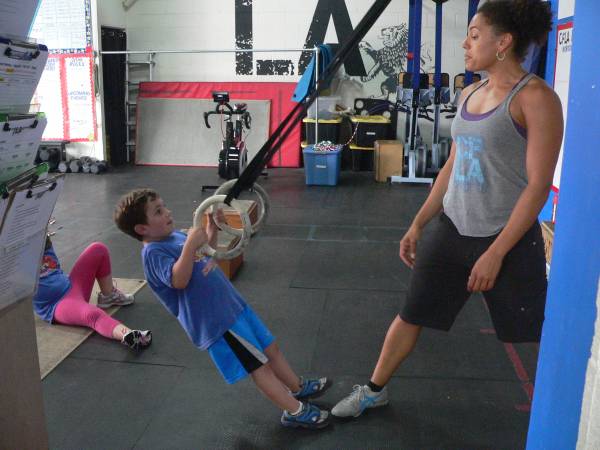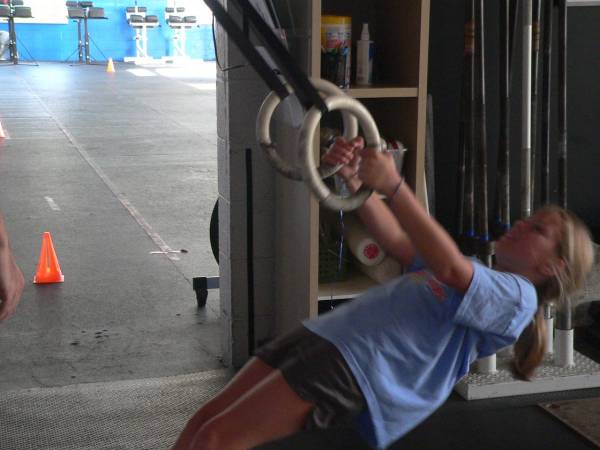There is a silent plague striking children today. You won’t hear about it on the evening news, and few doctors will talk about it, choosing instead to focus on the general issues of obesity and juvenile diabetes. Yet, this plague is striking more and more children, even ones who look otherwise healthy. I call it f-shoulders.
What Are f-Shoulders?
If you look at a child from the side, you will notice that starting at about the mid back, the body takes a curve forward, ending in a head that is held a few inches in front of the collarbones. Overall, the child’s body is shaped like a lowercase “f.”
The problem has numerous causes. Too many hours spent hunched over desks in school, furiously bubbling multiple choice test sheets. Too many hours spent hunched over a video game controller or tablet computer of some type, gaming their lives away. Not enough hours spent using their bodies.
Ramifications of f-Shoulders
These habits affect general health as well as athletic performance. In addition to increased chances of joint pain (specifically shoulder, neck, and low back pain), there are increased risks of injury, as well as decreased performance potential. After all, how can a football player block, or a baseball player swing a bat, or a tennis player get the most out of a swing of the racket if his or her back and shoulder muscles are weak and misaligned?
Treating the root causes of f-shoulders is essential. However, not everyone has available, or is willing to tolerate, a Shaolin monk who whacks their children with a stick every time their shoulders drop out of alignment. As coaches and parents, our best chance of making a positive change lies intreating the musculature itself. Stretching the pectoral region, as well as and strengthening the posterior chain and upper back muscles, will dramatically affect what the body looks like and how it performs.
Row, Row, Row Your Kids
For me, no movement hits the posterior chain and muscles in the upper back better than horizontal rows. What makes rows so awesome is that there are so many different variations. Bodyweight, rope, bar, barbell, dumbbell, banded, machine, cables – you name it, there’s probably a row variation that exists for it. The row is perfect for working posture because not only does it require retraction of the shoulder blades, but most variations also require stabilization from the lower back and abdominals. So not only do you get strengthening of the shoulders and upper back, you get postural practice and stabilization practice for the posterior chain. More bang for your training buck!

So what are the best rows for kids and teens? Here are my recommendations, in order of progression.
1. Supported Dumbbell Rows
Supported dumbbell rows are perhaps the best way to introduce row to trainees. The ability to support the non-working hand on the child’s knee or a bench allows for greater safety and support. I like introducing the supported row early, because for children who do not have the strength to do any of the following rows, this exercise is infinitely and easily scalable, from one pound to Hulk Smash. For kids, there is no reason yet for Kroc Rows or other super-heavy cheated rep rows.
2. Body Rows on the Bar
What I love about these is that they are scalable depending on the strength of the trainee. You can start with your feet on the floor, your feet on a bench, or even change the difficulty based off of the height of the bar. One negative aspect is that the hand placement can definitely affect the pull. If the hands are too wide, getting your body to the bar is difficult. In addition, pull location is important. I prefer to place the hands in between the xiphoid process and the nipples, using an overhand grip and trying to touch the body to the bar. If that still proves difficult, try using a neutral grip (hands facing each other), although this would require two bars or some other type of parallel grip setup. Using a reverse (palms up) grip targets the biceps more, but I don’t like the stress on the biceps tendon this position can create.
3. Suspended Rows
A variation on the body row, the unstable pulling surface adds a fun challenge. I find this is great mixed with other rows, either as a warm-up or as a finisher. TRX or other suspended rows are also the easiest way to mix in one-handed body rows, as the automatic supination of the wrist allows for the greatest strength curve of the arm.

4. Chest Supported Rows
This is my favorite movement for introducing bilateral barbell rows. Be careful that the trainee fits the machine. Shorter children could end up with a face full of chest pad, and a bar path that is too high. Of course, the tendency to relax the lower back is obvious here, but still a good introduction.
5. Barbell Rows
I love this lift, whether it be Pendlay Rows, Yates Rows, or anything in between. However I also understand how challenging they can be. Barbell rows are notoriously easy to cheat, and it is notoriously easy to screw yourself up by letting your inner bro take over, sacrificing trunk stability for a few pounds on the bar. Until your child or teen is ready and able to stabilize properly, hold off on this variation.
6. Face Pulls
These are super easy to do, and a staple of many powerlifters’ pre-hab and rehab routines. I personally think you should avoid adding these in until the other lifts are mastered, due to limited carryover to real life movements.
Rowing in Your Workouts
So, what is the best way to incorporate rows into your kids programs? I like to mix them up with real-life challenges in my kids classes and with personal training clients. I use them about two times a week as the primary lifts. In a recent kids’ class, our students started off with three sets of twenty seconds on the body row. After that they did relay races involving pulling a tire arm-over-arm, then ran the tire back to the starting point. In total, our kids probably did over 100 repetitions of a loaded rowing motion in just those exercises, in addition to our normal gymnastic work.
For coaches who are looking at incorporating rows into weight training, keep the total reps in the 50-75 range, with the primary focus on form. Get those shoulder blades retracted, and keep the trunk stable. I like to keep it in the ten-rep range for kids, not only because it makes the math easy (good for me!), but also because it’s a good number that requires a decent weight. It’s not high enough to make it a rep race, which can cause kids to sacrifice form for speed or reps.

Sample Program to Combat f-Shoulders
Here’s an example program with sets and reps that is easy to incorporate with kids. I limit it to two exercises, in order to keep time down, while also allowing full-body training. This workout focuses on pulling and limits the pushing to allow the body to rebalance itself.
1. Dumbbell Rows: 3×10, 60 seconds rest between sets, no rest between hands.
2. Push Ups: 3×30 second set, 30 seconds rest. (I put push ups here because of the large amounts of stabilization and lat activation needed to do them properly)
3a. Bounding Skips: 4 x 10 meters, supersetted with
3b. Standing One-Arm Band Rows: 4 x 12 (Be super strict on form. Time for swinging and yanking like a judo player comes later.)
4. Weighted Step Ups: 5 x 30 seconds
So let’s get our kids rowing and fight those f-shoulders! You’ll soon see heads up, chests out, and shoulders back. Your kids will look taller and perform at a higher level. What could be better?
Photos 1 and 4 courtesy of Shutterstock.
Photo 2 and 3 courtesy of CrossFit LA Kids.






